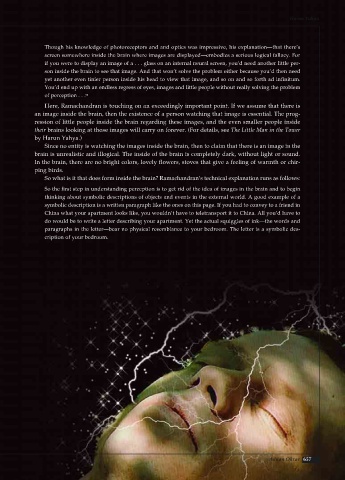Page 659 - Atlas of Creation Volume 4
P. 659
Harun Yahya
Though his knowledge of photoreceptors and and optics was impressive, his explanation—that there’s
screen somewhere inside the brain where images are displayed—embodies a serious logical fallacy. For
if you were to display an image of a . . . glass on an internal neural screen, you’d need another little per-
son inside the brain to see that image. And that won’t solve the problem either because you’d then need
yet another even tinier person inside his head to view that image, and so on and so forth ad infinitum.
You’d end up with an endless regress of eyes, images and little people without really solving the problem
of perception . . . 50
Here, Ramachandran is touching on an exceedingly important point. If we assume that there is
an image inside the brain, then the existence of a person watching that image is essential. The prog-
ression of little people inside the brain regarding these images, and the even smaller people inside
their brains looking at those images will carry on forever. (For details, see The Little Man in the Tower
by Harun Yahya.)
Since no entity is watching the images inside the brain, then to claim that there is an image in the
brain is unrealistic and illogical. The inside of the brain is completely dark, without light or sound.
In the brain, there are no bright colors, lovely flowers, stoves that give a feeling of warmth or chir-
ping birds.
So what is it that does form inside the brain? Ramachandran’s technical explanation runs as follows:
So the first step in understanding perception is to get rid of the idea of images in the brain and to begin
thinking about symbolic descriptions of objects and events in the external world. A good example of a
symbolic description is a written paragraph like the ones on this page. If you had to convey to a friend in
China what your apartment looks like, you wouldn’t have to teletransport it to China. All you’d have to
do would be to write a letter describing your apartment. Yet the actual squiggles of ink—the words and
paragraphs in the letter—bear no physical resemblance to your bedroom. The letter is a symbolic des-
cription of your bedroom.
Adnan Oktar 657

